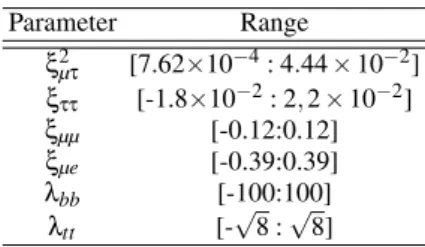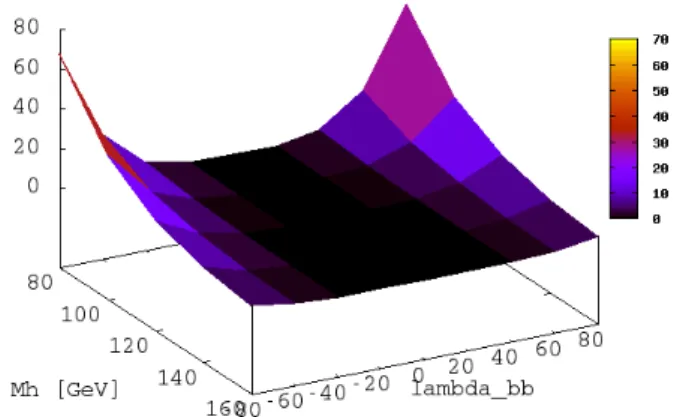Brazilian Journal of Physics, vol. 38, no. 3B, September, 2008 455
Light Higgs Boson Production in Two Higgs Doublets Models Type III
Camilo Andr´es Jim´enez-Cruz,∗ J.-Alexis Rodr´ıguez L´opez,† and Roberto Martinez‡ Departamento de F´ısica - Universidad Nacional de Colombia - Sede Bogota, Colombia
(Received on 16 April, 2008)
By using the Cheng, Sher and Yuan’s anzats, we study the light Higgs Boson production associated with bquark production at TEVATRON using the 2HDM type III. We compare the simulations with experimental results coming from TEVATRON, finding valid ranges for thebbcoupling. By using these results, we calculate the cross section for the processpp→bbh¯ (bb¯)for the LHC collider.
Keywords: Light Higgs Boson; b Production; LHC
I. INTRODUCTION
Although a relatively light Higgs boson coming from the SM can support the idea of the SM being true all the way to the Plank scale, most theorists consider such a possibility unlikely [1]. A light Higgs boson is preferred by precision fits of the Standard Model (SM) [2] and also theoretically required by many frameworks that can be effectively SM-like at low energies. The production of a Higgs boson in association with a heavy quark and antiquark pair (bothtt¯andbb¯) at hadron colliders will be sensitive to the Higgs-fermion couplings and can help discriminate between models. One of such models is the so-called 2HDM, which includes a second scalar doublet with the same properties of the first one.
In this paper, by using the framework of the 2HDM-III and the CSY anzats (section II), we calculate the associated b-quark/Higgs boson production at the TEVATRON collider. By comparing the results obtained in the simulation with experi-mental data released by the D0 collaboration we find bounds over the λbb parameter of the coupling (section III). The bounds found let us estimate the associated higgs/bottom pro-duction in the Large Hadron Collider (section IV). Finally, in section V we state our concluding remarks.
II. TWO HIGGS DOUBLET MODEL (2HDM)
The 2HDM includes a second scalar doublet, with each doublet acquiring a vacuum expectation value different from zero.
The scalar content of the model becomes:
Φi=
µ
φ+i φ0 i
¶
, hΦii=
µ
0 vi √ 2
¶
, i=1,2 (1)
In this way, the scalar spectrum of mass eigenvalues contains two CP-even neutral Higgs bosons(h0,H0)coming from the mixing of the real part of the neutral components of both dou-blets with a mixing angleα; two charged Higgs bosons (H±), which mix with the would-be Goldstone bosons (G±W) through
∗Electronic address:cajimenezc@unal.edu.co
†Electronic address:jarodriguezl@unal.edu.co ‡Electronic address:remartinezm@unal.edu.co
the mixing angle tanβ=v2/v1 and one CP-odd Higgs (A0), which mixes with the neutral would-be Goldstone.
A. The Yukawa Lagrangian
The most general Lagrangian that can be written in this kind of models includes interactions between all the fermions and both doublets:
−
L
Y = ηU,0i j Q¯0iLΦ˜1U0jR+η D,0
i j Q¯0iLΦ˜1D0jR + ξUi j,0Q¯0
iLΦ˜2U0jR+ξ D,0 i j Q¯
0 iLΦ˜2D0jR
+ l.s. + h.c (2)
The strong suppression of FCNC at tree level makes custom-ary to impose discrete symmetries over the doublets.
Those symmetries end in one of three types of models [3].
• Type I
Φ1is the responsible of giving mass to the matter, while Φ2decouples totally from them.
• Type II
Φ1 couples to the up sector whileΦ2 couples to the down sector. This is the case of the MSSM.
• Type III
Both doublets couple to both sectors.
B. 2HDM type III
As there are two non-diagonal 3×3 matrices in the Yukawa lagrangian, and the suffix 0 means that these fermion states are not mass eigenstates. It is clear that the mass terms for the
Parameter Range
ξ2
µτ [7.62×10−4: 4.44×10−2] ξττ [-1.8×10−2: 2,2×10−2]
ξµµ [-0.12:0.12]
ξµe [-0.39:0.39]
λbb [-100:100]
λtt
[-√ 8 :√8]
456 Camilo Andr´es Jim´enez-Cruz et al.
✁g b
b h
✁g b
b h
✁
g g
b h b
✁ ¯
q q
¯b h b
FIG. 1: Processes involved in the associatedφ/bproduction.
matter will depend on two Yukawa coupling matrices. The rotation of the quarks and leptons allow us to diagonalize one of the matrices but in general not both simultaneously, then one Yukawa coupling remains non-diagonal, leading to the FCNC at tree level.
C. Cheng, Sher and Yuan’s Anzats (CSY)
In this work, we use the CSY parameterization of the Yukawa’s couplings [4]. This anzats is based on the SMφff¯ couplings and states that
ξi j ≡
√m imj v λi j
This is an ansatz for the Yukawa texture matrices looking for a phenomenological similarity with SM couplings. Here,vhas been defined asv≡
q
v21+v2 2.
Some restrictions over the λi j and the ξi j parameter sets have been found [5] and can be seen in Table I. Theλbb pa-rameter can be costrained by the coupling of theb quark to the scalar sector.
III. ASSOCIATEDh0bb¯PRODUCTION
In the SM, the scalar sector couples to the fermions with strength proportional to the mass of the fermion. In this way, the Yukawa coupling to bottom quarks (mb∼5GeV) leads to small cross sections in hadron colliders. However, pro-cesses involvingbquarks and light Higgs bosons (Fig. 1) can be strongly enhanced in some 2HDM scenaries. This associ-ated production has been extensivelly studied for 2HDM type II [6-9], being the Minimal Supersymetric Standar Model a favorite framework for calculation. However, 2HDM type III models’ cross sections can be enhanced in a similar way.
The predominant modes are
qq,gg→bbh¯ 0(bb),¯ andgb→bh(bb)¯ (3)
FIG. 2: Light Higgs boson production associated with two highpt b-quarks and decaying into abb¯pair, for different values ofλbband Mh,α=√2/2.
so the interesting events would have at least four jets in the final state where two of these jets should come from a Higgs resonance. The signal-to-background ratio can be enhanced by requiring that the four jets (or at least three) of the highest transverse energies are tagged as b-jets. This mode could be of great interest when the mass of the scalar boson is greater than 150MeV, where the sensitivity to theh→ττchannel dis-appears [10].
Specifically, in the frame of the 2HDM-III and by using the CSY anzats, the coupling between the lightest Higgs boson and thebquarks is given by
A(h0bb) =¯ h0b¯
µ
cosα+sinαtanβ √
2 ξ
D−sinα v mb
¶
b (4)
whereαandβare the angles defined before.
In terms of thefundamental parameterization[3], the cou-pling becomes
A(h0bb) =¯ h0b¯
µ
−sinvαmb+ cosα
√ 2
mb v λbb
¶
b. (5)
where we see explicitelly the high dependence on theλbb pa-rameter defined in the CSY anzats.
IV. RESULTS
By using the CalcHEP package [12] as the Monte Carlo event generator, we calculated the associated bottom-quark/Higgs production in the TEVATRON collider for dif-ferent values ofλbbandmφ. The results can be seen in Figure 2. We used the CTEQ6M Parton Distribution Function for the proton and the antiproton, a momentum of 1980GeV at center of mass and a representative value ofα=π/4.
Brazilian Journal of Physics, vol. 38, no. 3B, September, 2008 457
FIG. 3: Plot matching experimental data [11] comming from the D0 experiment (TEVATRON) and simulated data runningmhandλbb.
FIG. 4: Estimated cross section for the associated bottom quark pro-duction for the LHC collider (pp→bbh¯ (bb¯)), here we usedλbb=6.
distinguished experimentally [11] and the total cross section for the signal is assumed to be twice of the light boson [13].
The total cross section for the process is then [13]:
σ(pp¯→bbh¯ 0→bbb¯ b)¯ ∼2×σ(pp¯→bbφ)¯ ×BR(h0→bb).¯ (6) The results were matched against experimental results com-ming from the D0 experiment [11] (Fig. 3), showing a great agreement for small values ofλbb. In this way, we got the following bounds over theλbbparameter, givenα∼√22:
−6≤λbb≤6 (7)
.
By using the bounds obtained, we can estimate the associ-ated b-quark-higgs boson production rates for the LHC col-lider. The results are depicted in the Fig. 4.//
V. CONCLUDING REMARKS
The coupling between the light neutral Higgs boson and the fermions is quite sensitive to the existence of a non-minimal scalar sector.
By using the Cheng, Sher and Yuang parameterization of the coupling between thebquark and the scalar sector we cal-culated the total cross section for the process pp¯→bbh(b¯ b)¯ at a center of mass energy of 1.98TeV. We compared this re-sult with the reported data comming from the D0 experiment at TEVATRON [14]. In this way, we obtained that theλbb parameter of the anzats should be in the range[−6,6] improv-ing the actual bound provided by unitarity and included in the table I.
With this results, we calculated the associatedbquark pro-duction of the light Higgs boson for the LHC.
Acknowledgments
R.M. acknowledges the finantial support of the Banco de la Republica de Colombia.
[1] M. Carena, J. S. Conway, H. E. Haber, and J. D.
Hobbs, Report of the Higgs Working Group of the
Tevatron Run 2 SUSY/Higgs Workshop, (2000), URL http://www.citebase.org/abstract?id=oai:arXiv.org:hep-ph/0010338.
[2] T. L. C. A. Collaboration, D. Collaboration, L. Collab-oration, O. Collaboration, and the LEP Electroweak Working Group, Precision Electroweak Measurements and Constraints on the Standard Model, 2007, URL http://www.citebase.org/abstract?id=oai:arXiv.org:0712.0929. [3] R. A. Dias, Phenomenological analysis of the Two Higgs
Doublet Model, 2002,
URL http://www.citebase.org/abstract?id=oai:arXiv.org:hep-ph/0212237.
[4] M. Sher,Scalar-Mediated Flavor-Changing Neutral Currents, (1998),
URL http://www.citebase.org/abstract?id=oai:arXiv.org:hep-ph/9809590,
[5] R. Martinez, D. A. Milanes, and J. -Alexis Rodriguez, Phys. Rev. D,72, 035017 (2005),
URL http://www.citebase.org/abstract?id=oai:arXiv.org:hep-ph/0502087.
[6] J. Campbell, R. K. Ellis, F. Maltoni, and S. Willenbrock, 2003, URL, arXiv:hep-ph/0204093v2.
[7] S. Dawson, C. B. Jackson, L. H. O, L. Reina, and D. Wackeroth, 2003, URL, arXiv:hep-ph/0311216v1.
Willen-458 Camilo Andr´es Jim´enez-Cruz et al.
brock 2004, URL arXiv:hep-ph/0405302v1. [9] M. Kramer 2004, URL, arXiv:hep-ph/0407080v1. [10] A. Collaboration, Tech. Rep. CERN (2000).
[11] D0 Collaboration and V. Abazov, Phys. Rev. Lett.95, 151801 (2005),
URL http://www.citebase.org/abstract?id=oai:arXiv.org:hep-ex/0504018.
[12] A. Pukhov et al, arXiv:hep-ph/9908288, 2007.
[13] M. Carena, S. Heinemeyer, C. E. M. Wagner, and G. Weiglein, European Physical Journal C, 45, 797 (2006), URL http://www.citebase.org/abstract?id=oai:arXiv.org:hep-ph/0511023.


